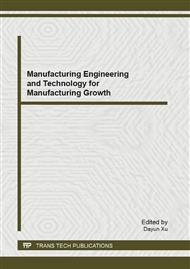[1]
Bogdan, R. C., & Biklen, S. K. (2007). Qualitative research for education: An introduction for theories and methods. Boston, MA: Pearson Education.
Google Scholar
[2]
Wiig, K., (2004). People focused knowledge management. Boston, MA: Butterworth Heinemann.
Google Scholar
[3]
Sharples, M., Corlett, D., Westmancott, O., (2002). The design and implementation of a mobile learning resource. Personal and Ubiquitous Computing, 6, 220-234.
DOI: 10.1007/s007790200021
Google Scholar
[4]
Liang, L. T., Huang, C. W., Yeh, Y. H., & Lin, B., (2007). Adoption of mobile technology in business: a fit-viability model. Industrial Management & Data Systems, 107(8) 1154-1169.
DOI: 10.1108/02635570710822796
Google Scholar
[5]
Liaw, S. S., Hatala, M., & Huang, H. M., (2010). Investing acceptance toward mobile learning to assist individual knowledge management: Based on activity theory approach. Computers & Education, 54, 446-454.
DOI: 10.1016/j.compedu.2009.08.029
Google Scholar
[6]
Clough, G., Jones, A. C., McAndrew, P., & Scanlon, E. (2007). Informal learning with PDAs and Smartphones. Journal of Computer Assisted Learning, 24, 359-371.
DOI: 10.1111/j.1365-2729.2007.00268.x
Google Scholar
[7]
Teece, D. J. (1986). Profiting from technological innovation: Implications for integration, collaboration, licensing and public policy. Research Policy, 15, 285-305.
DOI: 10.1016/0048-7333(86)90027-2
Google Scholar
[8]
Rahmandad, H., (2008). Effect of Delays on Complexity of Organizational Learning. Management Science, 54(7), 1297-1312.
DOI: 10.1287/mnsc.1080.0870
Google Scholar
[9]
Carayannis, E. G. (2008).
Google Scholar
[10]
Hemp, P. (2009). Death by Information Overload: New research and novel techniques offer a lifetime to you and your organization. Harvard Business Review, 83-89.
Google Scholar
[11]
Carayannis, E. G., & Sipp, C. M., (2010). Why, when and how are real options used in strategic technology venturing? Journal of the Knowledge Economy. 1(2) 70-85.
DOI: 10.1007/s13132-010-0011-x
Google Scholar
[12]
Carayannis, E.G., & Clark, C. S., (2011). Do smartphones make for smarter business? The smartphone CEO study. Journal of the Knowledge Economy. 2(2) 201-233.
DOI: 10.1007/s13132-011-0044-9
Google Scholar
[13]
Foster, A., Ford, N., (2003). Serendipity and information seeking: an empirical study. Journal of Documentation, 59(3), 321-340.
DOI: 10.1108/00220410310472518
Google Scholar
[14]
Carayannis, E. G., & Sipp, C. M., (2010). Why, when and how are real options used in strategic technology venturing? Journal of the Knowledge Economy. 1(2) 70-85.
DOI: 10.1007/s13132-010-0011-x
Google Scholar
[15]
Foster, A., Ford, N., (2003). Serendipity and information seeking: an empirical study. Journal of Documentation, 59(3), 321-340.
DOI: 10.1108/00220410310472518
Google Scholar
[16]
Carayannis, E. G. (2008).
Google Scholar
[17]
Knott, A. M., Posen, H. E., & Wu, B., (2009), Spillover Asymmetry and Why It Matters. Management Science, 55(3), 373-388.
DOI: 10.1287/mnsc.1080.0950
Google Scholar
[18]
Kim, W. C., & Mouborgne, R., (1997), Fair Process: Managing the Knowledge Economy. Harvard Business Review, 65-75.
Google Scholar
[19]
Liaw, S. S., Hatala, M., & Huang, H. M., (2010). Investimg acceptance toward mobile learning to assist individual knowledge management: Based on activity theory approach. Computers & Education, 54, 446-454.
DOI: 10.1016/j.compedu.2009.08.029
Google Scholar
[20]
Ibarra, H., & Hunter, M. (2007), How Leaders Create and Use Networks. Harvard Business Review, 40-47.
Google Scholar


